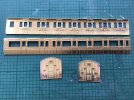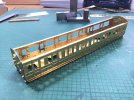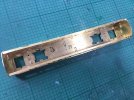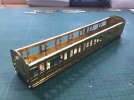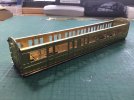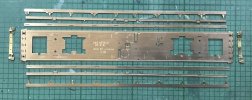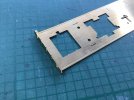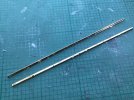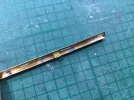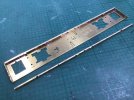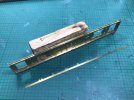A journey begins
Heather Kay
Western Thunderer
I do try, but sometimes a thread title doesn’t work on the first go. I’ll think on it.
It started with a phone call. A chap called and asked if I’d be interested in helping him by building some coaches. Well, as it’s more or less what I do these days, I said I was happy to chat about it further. I do try to take notes when chatting on the phone, but it made much more sense for him to email me with more details. I prefer email as it’s easier to keep a digital paper trail of correspondence.
The project sounded interesting. As we were going to be in Shropshire attending a modelling exhibition of some flavour, we arranged that we might pay a visit to give everything a proper looking at. We arrived one morning, were ushered into the rather grand house, and diverted into the dining room. The not insubstantial table was covered in lots of bits of Great Eastern Railway brass coach kits, all neatly laid out for inspection.
The upshot of it all was the client had acquired a selection of part-built models from a good friend who had died a few years before. The client wasn’t happy building coaches, being much more interested in goods stock and operation. He was building a P4 layout set around the London area modelling LNER in 1928, and wanted to have the coaches completed so he could run them in the fashion of passing trains while the fun part of shunting was going on in the foreground. He also wanted to have them finished as a tribute to commemorate his late friend.
Well, I looked at the parts, we chatted about what was wanted, and it all looked fairly straightforward. We agreed an estimated price per coach to complete to a certain specification, which was to be set out fully in due course. We left, not taking the kits with us. The client was going to acquire some further kits and various components and upgrades, and would be happy to bring it all down to sunny Kent at a later date.
At that later date, I received a plastic tool box full of the part-built kits. There was a detailed folder with outline information about the coaches, and a stack of society journals all carefully annotated. On the understanding I couldn’t get stuck in for some time, we left it that I should assess what was required to complete the builds, the client would buy everything and arrange for it to be delivered to me.
And so, over the intervening three years or so, more and more bits and bobs have turned up. Into the mix has been added some Isinglass 3D printed Quints, but they’re definitely for another day.
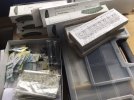
Elsewhere on WT, you may have noted I’ve been tracklaying on my test plank. The time had come to get serious about the boxes that had been slowly gathering dust on the top of my build queue shelf. At first blush, it was a daunting mass of all sorts. I spent a while sorting, unwrapping and generally trying to work out what I had taken on.
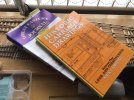
Knowing next to nothing about things Great Eastern Railway, the pile of reference material made a good read. With a slightly better understanding of what the coaches were and what they looked like, I began to sort stuff out.
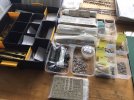
I have spent this morning going through lots of bags of castings. To try and be methodical about this multiple build - there will be 16 50ft coaches to start with - I separated castings into various tubs. Bogie details, underframe, body details, roof details. The original builder had done quite a good job on the sides, ends and underframes, so all I need to do is clean them and make and minor repairs as necessary. There are five builds to start, and I’m thinking I might kick off with one of them to familiarise myself with the way they are supposed to be assembled.
Discussion has been had about couplings, roofs and gangways. It is expected there will be two complete rakes of coaches, topped and tailed by brake thirds. The outer ends of the brakes will have good detailing, and Dingham couplers. The rest will be joined together with some form of semi-permanent coupling, and probably cardboard-style gangways. The kit roofs are vacuum formed styrene sheet, and although almost three decades old they are still in relatively good order. Nevertheless, the client wants to go for aluminium extruded section roofs, so we’ll have to order some from Wizard Models. I have plenty to occupy me before I get that far! Aside from the supplied interior partitions, it’s been agreed that no seating need be fitted.
In a future post, I shall give a bit more detail on what the various diagrams are, and how we hope things will end up. Let the adventure begin!
It started with a phone call. A chap called and asked if I’d be interested in helping him by building some coaches. Well, as it’s more or less what I do these days, I said I was happy to chat about it further. I do try to take notes when chatting on the phone, but it made much more sense for him to email me with more details. I prefer email as it’s easier to keep a digital paper trail of correspondence.
The project sounded interesting. As we were going to be in Shropshire attending a modelling exhibition of some flavour, we arranged that we might pay a visit to give everything a proper looking at. We arrived one morning, were ushered into the rather grand house, and diverted into the dining room. The not insubstantial table was covered in lots of bits of Great Eastern Railway brass coach kits, all neatly laid out for inspection.
The upshot of it all was the client had acquired a selection of part-built models from a good friend who had died a few years before. The client wasn’t happy building coaches, being much more interested in goods stock and operation. He was building a P4 layout set around the London area modelling LNER in 1928, and wanted to have the coaches completed so he could run them in the fashion of passing trains while the fun part of shunting was going on in the foreground. He also wanted to have them finished as a tribute to commemorate his late friend.
Well, I looked at the parts, we chatted about what was wanted, and it all looked fairly straightforward. We agreed an estimated price per coach to complete to a certain specification, which was to be set out fully in due course. We left, not taking the kits with us. The client was going to acquire some further kits and various components and upgrades, and would be happy to bring it all down to sunny Kent at a later date.
At that later date, I received a plastic tool box full of the part-built kits. There was a detailed folder with outline information about the coaches, and a stack of society journals all carefully annotated. On the understanding I couldn’t get stuck in for some time, we left it that I should assess what was required to complete the builds, the client would buy everything and arrange for it to be delivered to me.
And so, over the intervening three years or so, more and more bits and bobs have turned up. Into the mix has been added some Isinglass 3D printed Quints, but they’re definitely for another day.

Elsewhere on WT, you may have noted I’ve been tracklaying on my test plank. The time had come to get serious about the boxes that had been slowly gathering dust on the top of my build queue shelf. At first blush, it was a daunting mass of all sorts. I spent a while sorting, unwrapping and generally trying to work out what I had taken on.

Knowing next to nothing about things Great Eastern Railway, the pile of reference material made a good read. With a slightly better understanding of what the coaches were and what they looked like, I began to sort stuff out.

I have spent this morning going through lots of bags of castings. To try and be methodical about this multiple build - there will be 16 50ft coaches to start with - I separated castings into various tubs. Bogie details, underframe, body details, roof details. The original builder had done quite a good job on the sides, ends and underframes, so all I need to do is clean them and make and minor repairs as necessary. There are five builds to start, and I’m thinking I might kick off with one of them to familiarise myself with the way they are supposed to be assembled.
Discussion has been had about couplings, roofs and gangways. It is expected there will be two complete rakes of coaches, topped and tailed by brake thirds. The outer ends of the brakes will have good detailing, and Dingham couplers. The rest will be joined together with some form of semi-permanent coupling, and probably cardboard-style gangways. The kit roofs are vacuum formed styrene sheet, and although almost three decades old they are still in relatively good order. Nevertheless, the client wants to go for aluminium extruded section roofs, so we’ll have to order some from Wizard Models. I have plenty to occupy me before I get that far! Aside from the supplied interior partitions, it’s been agreed that no seating need be fitted.
In a future post, I shall give a bit more detail on what the various diagrams are, and how we hope things will end up. Let the adventure begin!


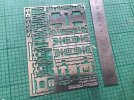

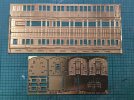
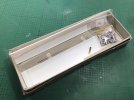
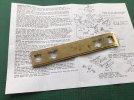
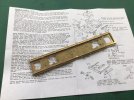
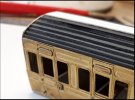
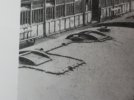
 I just checked an etched end with the plastic roof, and it’s not a million miles off, just needing a tiny adjustment with the file on the end radii.
I just checked an etched end with the plastic roof, and it’s not a million miles off, just needing a tiny adjustment with the file on the end radii.